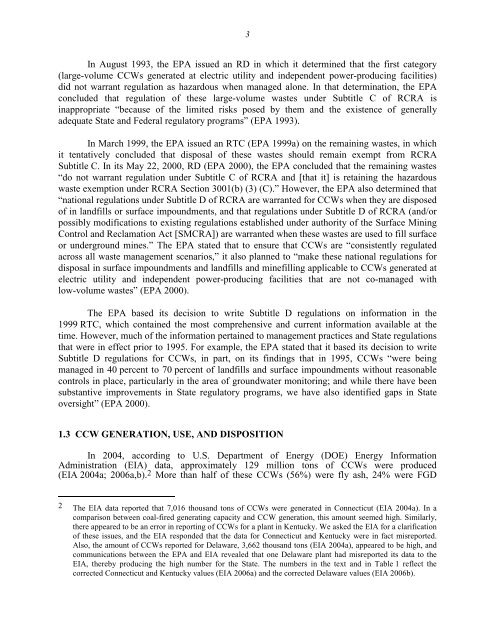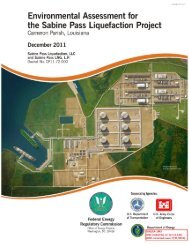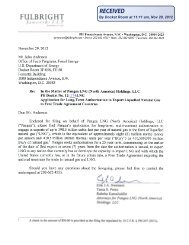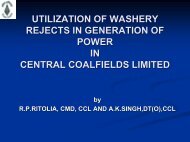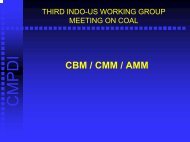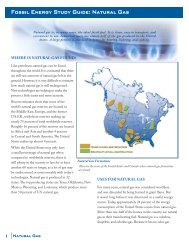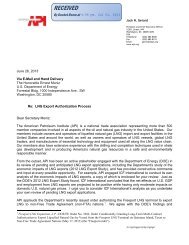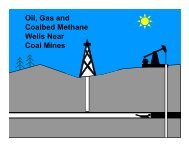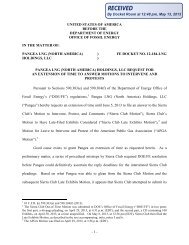Coal Combustion Waste Management at - DOE - Fossil Energy ...
Coal Combustion Waste Management at - DOE - Fossil Energy ...
Coal Combustion Waste Management at - DOE - Fossil Energy ...
Create successful ePaper yourself
Turn your PDF publications into a flip-book with our unique Google optimized e-Paper software.
3<br />
In August 1993, the EPA issued an RD in which it determined th<strong>at</strong> the first c<strong>at</strong>egory<br />
(large-volume CCWs gener<strong>at</strong>ed <strong>at</strong> electric utility and independent power-producing facilities)<br />
did not warrant regul<strong>at</strong>ion as hazardous when managed alone. In th<strong>at</strong> determin<strong>at</strong>ion, the EPA<br />
concluded th<strong>at</strong> regul<strong>at</strong>ion of these large-volume wastes under Subtitle C of RCRA is<br />
inappropri<strong>at</strong>e “because of the limited risks posed by them and the existence of generally<br />
adequ<strong>at</strong>e St<strong>at</strong>e and Federal regul<strong>at</strong>ory programs” (EPA 1993).<br />
In March 1999, the EPA issued an RTC (EPA 1999a) on the remaining wastes, in which<br />
it tent<strong>at</strong>ively concluded th<strong>at</strong> disposal of these wastes should remain exempt from RCRA<br />
Subtitle C. In its May 22, 2000, RD (EPA 2000), the EPA concluded th<strong>at</strong> the remaining wastes<br />
“do not warrant regul<strong>at</strong>ion under Subtitle C of RCRA and [th<strong>at</strong> it] is retaining the hazardous<br />
waste exemption under RCRA Section 3001(b) (3) (C).” However, the EPA also determined th<strong>at</strong><br />
“n<strong>at</strong>ional regul<strong>at</strong>ions under Subtitle D of RCRA are warranted for CCWs when they are disposed<br />
of in landfills or surface impoundments, and th<strong>at</strong> regul<strong>at</strong>ions under Subtitle D of RCRA (and/or<br />
possibly modific<strong>at</strong>ions to existing regul<strong>at</strong>ions established under authority of the Surface Mining<br />
Control and Reclam<strong>at</strong>ion Act [SMCRA]) are warranted when these wastes are used to fill surface<br />
or underground mines.” The EPA st<strong>at</strong>ed th<strong>at</strong> to ensure th<strong>at</strong> CCWs are “consistently regul<strong>at</strong>ed<br />
across all waste management scenarios,” it also planned to “make these n<strong>at</strong>ional regul<strong>at</strong>ions for<br />
disposal in surface impoundments and landfills and minefilling applicable to CCWs gener<strong>at</strong>ed <strong>at</strong><br />
electric utility and independent power-producing facilities th<strong>at</strong> are not co-managed with<br />
low-volume wastes” (EPA 2000).<br />
The EPA based its decision to write Subtitle D regul<strong>at</strong>ions on inform<strong>at</strong>ion in the<br />
1999 RTC, which contained the most comprehensive and current inform<strong>at</strong>ion available <strong>at</strong> the<br />
time. However, much of the inform<strong>at</strong>ion pertained to management practices and St<strong>at</strong>e regul<strong>at</strong>ions<br />
th<strong>at</strong> were in effect prior to 1995. For example, the EPA st<strong>at</strong>ed th<strong>at</strong> it based its decision to write<br />
Subtitle D regul<strong>at</strong>ions for CCWs, in part, on its findings th<strong>at</strong> in 1995, CCWs “were being<br />
managed in 40 percent to 70 percent of landfills and surface impoundments without reasonable<br />
controls in place, particularly in the area of groundw<strong>at</strong>er monitoring; and while there have been<br />
substantive improvements in St<strong>at</strong>e regul<strong>at</strong>ory programs, we have also identified gaps in St<strong>at</strong>e<br />
oversight” (EPA 2000).<br />
1.3 CCW GENERATION, USE, AND DISPOSITION<br />
In 2004, according to U.S. Department of <strong>Energy</strong> (<strong>DOE</strong>) <strong>Energy</strong> Inform<strong>at</strong>ion<br />
Administr<strong>at</strong>ion (EIA) d<strong>at</strong>a, approxim<strong>at</strong>ely 129 million tons of CCWs were produced<br />
(EIA 2004a; 2006a,b). 2 More than half of these CCWs (56%) were fly ash, 24% were FGD<br />
2 The EIA d<strong>at</strong>a reported th<strong>at</strong> 7,016 thousand tons of CCWs were gener<strong>at</strong>ed in Connecticut (EIA 2004a). In a<br />
comparison between coal-fired gener<strong>at</strong>ing capacity and CCW gener<strong>at</strong>ion, this amount seemed high. Similarly,<br />
there appeared to be an error in reporting of CCWs for a plant in Kentucky. We asked the EIA for a clarific<strong>at</strong>ion<br />
of these issues, and the EIA responded th<strong>at</strong> the d<strong>at</strong>a for Connecticut and Kentucky were in fact misreported.<br />
Also, the amount of CCWs reported for Delaware, 3,662 thousand tons (EIA 2004a), appeared to be high, and<br />
communic<strong>at</strong>ions between the EPA and EIA revealed th<strong>at</strong> one Delaware plant had misreported its d<strong>at</strong>a to the<br />
EIA, thereby producing the high number for the St<strong>at</strong>e. The numbers in the text and in Table 1 reflect the<br />
corrected Connecticut and Kentucky values (EIA 2006a) and the corrected Delaware values (EIA 2006b).


